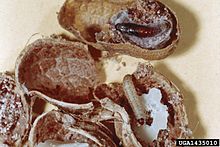Cadra
| Cadra | |
|---|---|

| |
| Almond moth (C. cautella), caterpillar (below) and pupa (above) in peanut husks | |
| Scientific classification | |
| Domain: | Eukaryota |
| Kingdom: | Animalia |
| Phylum: | Arthropoda |
| Class: | Insecta |
| Order: | Lepidoptera |
| Family: | Pyralidae |
| Tribe: | Phycitini |
| Genus: | Cadra Walker, 1864 |
| Species | |
|
Several, see text | |
| Synonyms | |
| |
Cadra is a genus of small moths belonging to the family Pyralidae. The genus Ephestia is closely related to Cadra and might be its senior synonym. Several of these moths are variously assigned to one or the other genus, in particular in non-entomological sources. Cadra and Ephestia belong to the huge snout moth subfamily Phycitinae, and therein to the tribe Phycitini.
Cadra species can usually be recognized by their reduced forewing venation: veins 4, 7 and 9 are missing, making for a total of nine veins in the forewing. Some members of this genus are significant pests of dry plant produce, such as seeds and nuts. The almond moth (C. cautella) is a well-known example of these.[1]
Species[edit]
- Cadra abstersella (Zeller, 1847)
- Cadra acuta Horak, 1994
- Cadra calidella (Guenée, 1845) – dried fruit moth, carob moth
- Cadra cautella – almond moth
- Cadra corniculata Horak, 1994
- Cadra delattinella Roesler, 1965
- Cadra figulilella – raisin moth
- Cadra furcatella (Herrich-Schäffer, 1849)
- Cadra furcatella afflatella
- Cadra furcatella calonella
- Cadra perfasciata Horak, 1994
- Cadra reniformis Horak, 1994
- Cadra rugosa Horak, 1994
Footnotes[edit]
- ^ Clarke (1986)
- ^ "GlobIZ search". Global Information System on Pyraloidea. Retrieved June 21, 2017.
References[edit]
- Clarke, John Frederick Gates (1986): Pyralidae and Microlepidoptera of the Marquesas Archipelago. Smithsonian Contributions to Zoology 416: 1–485. PDF full text Archived 2012-03-27 at the Wayback Machine (214 MB!)
- Savela, Markku (2009): Markku Savela's Lepidoptera and Some Other Life Forms – Cadra. Version of 14 April 2009. Retrieved 10 April 2010.
